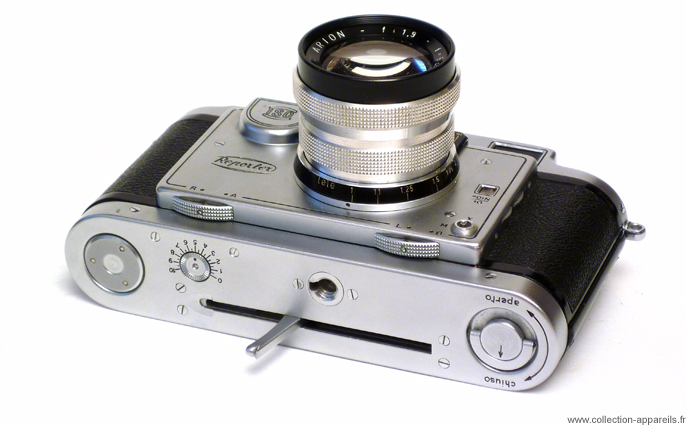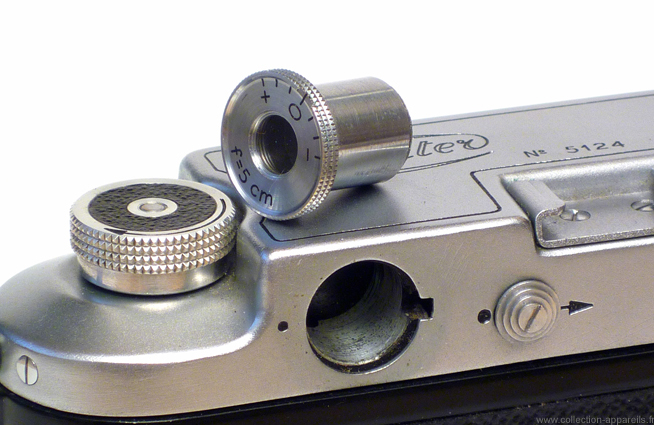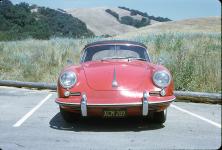|
Iso Reporter |
Manufactured or assembled in Italy from 1954 to (Circa) 1960.
Index of rarity in France: Rare (among non-specialized garage sales)
Inventory number: 2340
See the complete technical specifications
Chronology of cameras Iso
Traduction de Manuel M
This Italian rangefinder camera, is, like the Super Duplex 120, of a exceptional level of manufacturing and completion. He represents a kind of synthesis between Contax and Leica, while preserving some elegance.
To examine it is a pleasure so much the details are carefully done. The black edgings on the front and around the windows are some of more beautiful effect. Just as the leathering on the serrated rollers of cocking and rewinding.
The Reporter, like his almost twin brother, the Standard, derive both from the Bilux, appeared in 1950.
The Reporter accepts the lenses of the brand to diameter 36. This specimen is equipped with a splendid coated 50 mm Iso Arion lens opened to 1.9. The back of the lens is also coated.
One 50 mm open to 2.8, with retracting mount was also available.
The lens does not have focusing itself, this one being done by the advance of the screwmount, ordered, as on certain Contax, by a cogwheel.. Whereas Contax allow a locking of focusing only on the infinite, the reporter allows it at all distances, thanks to the locking button located on the left and at the bottom of the front. A black plate with marks of depth of field is located above the lens and reversed, so that it is readable from the top by the user.
Beyond the minimum distance of 1 m, the mounting ring of lens is engraved of a “tele” marking, of which I do not know the function, not having a telelens, nor the user manual of the camera (call to the contributors…)
The rangefinder is coupled with the lens and the viewfinder, by image superposition system. There is also an adjustment of dioptric correction.
The back latch on the right of the viewfinder makes it possible to leave the eyepiece to adapt of them one whose view angle corresponds to the lens used. This is why it is marked 5 cm on this one, which corresponds to the focal distance of the lens.
The focal plane shutter offer speeds reaching the 1/1000 second. The cocking can be done either classically by rotation of a serrated roller or, a more original way and especially faster, by a lever under the sole which is folded up when not in use. Two movements are necessary for the cocking. This system is similar to that of Leicavit or CanonVT.
The round button near to the lever and marked from 1 to 10 is intended to synchronize the curtains of the shutter according to the various magnesic bulbs available at the time. The synchro-flash socket, located in front, also accepts the electronic flashes.
The adjustment speeds is sophisticated enough.
The pose T and of from the second to the 1/15 are carried out by position of the values in the window located in front of the shutter release, by means of the serrated roller at the back of the body. To reach at high speeds, as with the pose B, it is necessary to position the value over the 1/30 (in red), then to select the speed desired on the traditional serrated roller speeds.
Two notches on the crown of the shutter release, as well as the partial rotatioon of this one let suppose a possibility of locking of release, but it seems inoperative on my specimen.
And the ever-ready case? … What about the case? Well also is rather particular: the round side serrated roller on the bottom is used to fix a foot, but does not unscrew in a banal way to extract the camera. The extraction is done very easily per quarter of rotation of the central lever. The opposite way is followed for fixing. Ingenious, does not ?
The nuts of foot located on the case and the camera itself are of different diameters.
What else?
The lower part of the case is not out of leather, but solid metal plate covered with a granit-like painting of the same colour than the leather.
The camera does not have exposure meter, nor of self timer, but as for former Bugatti’s, one forgets certain details so much the rest is beautiful!
The ISO Reporter was also manufactured by ISO for the company Hensoldt, partially held by Zeiss Ikon. It was renamed Henso Reporter with mention of the city of the head office of Hensoldt, Wetzlar. Except the name, nothing changes.
It would seem that 1,000 to 1,500 specimens of ISO Reporter were produced only from 1954 to 1960, which makes of it a rarity now.
The specimen presented would be, according to its serial number, the 124th manufactured. The number of the lens is rather close: 172.




Interesting links or bibliography :
Add a link or element of bibliography, a picture taken with this camera, a picture of box or an ads about this camera
Your photos taken with the same camera:
Cameras from Ebay France (Iso) (Uploaded each 3 hours)
 ancien appareil photo AGFA ISO BOX années 30 19,00 euros Finira le 27-04-2024 à 09:28:11 |  Pellicule photo Fnac 200 iso 24 poses 10,00 euros Finira le 29-04-2024 à 17:02:57 |  APPAREIL PHOTO ARGENTIQUE VINTAGE AGFA ISO-RAPID I - Allemagne 1964 19,00 euros Finira le 01-05-2024 à 15:17:39 |








